This area is situated in the unique department of the Gironde. With 292 820 acres of vines, it is the biggest wine-growing region in the world in PDO. The Bordelais climate is ideal for cultivating the vine. The area is situated right between the North Pole and the Equator (on the 45th parallel). The influence of the surrounding water with the Atlantic Ocean, the Gironde estuary and two major rivers regulates the climate.
The first distinction we can establish in this wine-growing area is the regional appellations:
PDO Médoc and PDO Haut Médoc where we can find local appellations (Listrac-Médoc, Moulis-en-médoc, Margaux, Pauillac, Saint-Estèphe et Saint-Julien, the last four appellations include ‘grands crus’ classified from first to fifth but also a lot of ‘crus bourgeois’). The Graves region, situated between the Garonne and the plateau of the Landes inculdes three PDOs : Graves, Graves supérieurs and Pessac-Léognan. The classification of ‘grands crus’ in Graves took place on February, 12 1959.
The Sauternais region, situated in the south-east of Bordeaux, is the reference for white dessert wines around the world. The famous Château Yquem was classified as ‘premier cru supérieur’ in 1855. The formation of autumn fog favours the development of a fungus (Botrytis cinerea), which means that noble rot forms on the grapes making them concentrated in sugar and aromas. The grape harvest is later than normal and some ‘grands crus’ choose only the best grapes and pick them one by one. This region has seven PDOs : Barsac, Loupiac, Sauternes ,Cerron ,Sainte Croix du Mont ,Cadillac and Côtes de Bordeaux Saint Macaire.
The region named L'Entre-Deux-Mers, situated between the Garonne and the Dordogne, includes a lot of appellations of which the most famous is PDO Entre-Deux-Mers.
The Blaye, Côtes-de-Blaye, Premières-Côtes-de-Blaye and Côtes-de-Bourg PDOs are situated on the right bank of the Dordogne and the Gironde.
The great wine-growing region located on the right bank of the Dordogne, named Libournais, includes the most prestigious appellations such as Saint-Émilion or Pomerol, well-known by its famous Château Pétrus.
